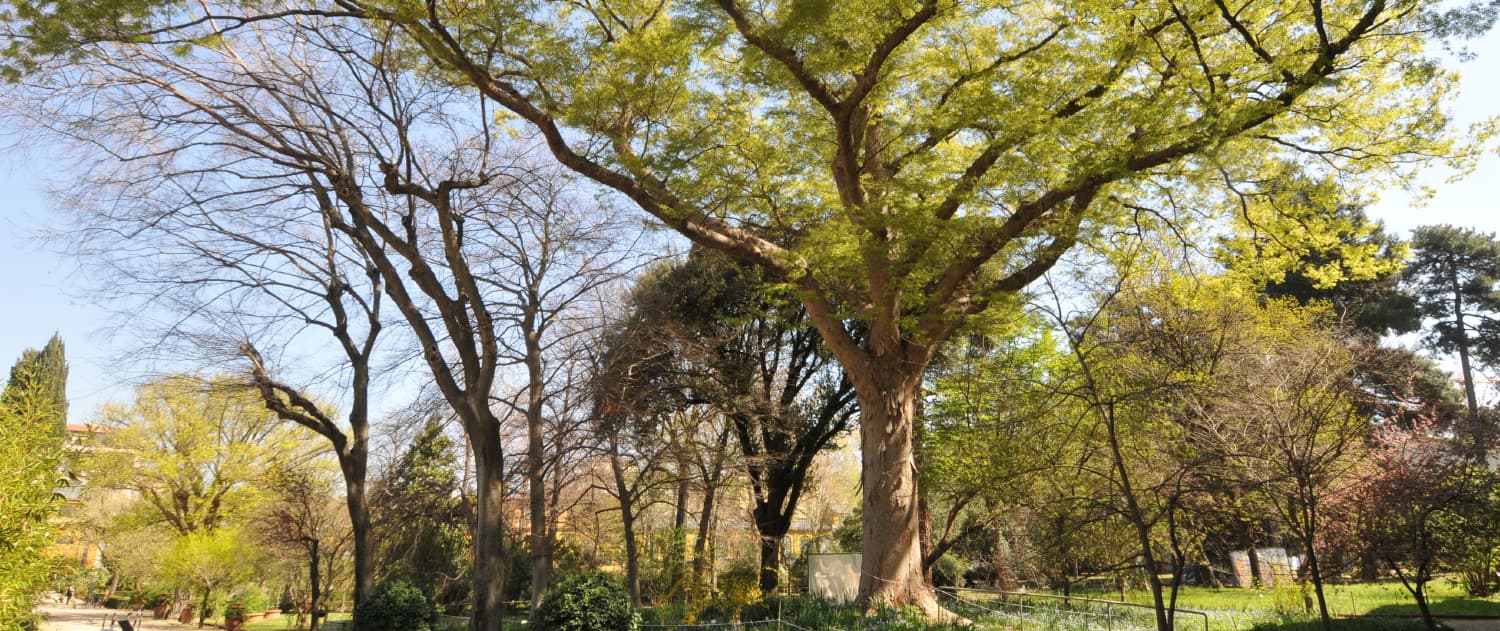Botanical Garden of Florence
Trees
Introduction | Acquatic | Citrus fruits | Trees | Wild edible plants | Araceae family | Wild shrubs | Begonias | Bromeliads | Carnivorous | Cycads | Grasses | Medicinals | Tropical orchids | Palms | Pteridophytes | Roses | Serpentinophytes | Succulent plants | Exhibits
The Botanical Garden hosts more than 150 trees of over 90 different species. Among this huge diversity, changing from season to season, there are trees that are particularly important due to their age, majesty, historical-cultural importance or their influence on the landscape. Since november 2024, these trees are included in the List of Monumental Trees of Italy (link in Italian).
In particular:
- the Yew (Taxus baccata) is the oldest specimen in the Garden. It was sown in 1720 by Pier Antonio Micheli, one of the most important directors of the Botanical Garden of Florence and trusted botanist to Grand Duke Cosimo III. The tree hosted in the Botanical Garden is a male individual, as the yew is a species that presents male and female reproductive structures on separate individuals. Long-living and very slow-growing species, the yew is considered a rare plant: in the wild it grows together with beech and holly in a habitat protected by the EU Habitats Directive.
- the Cork (Quercus suber) was planted in 1805 by Ottaviano Targioni Tozzetti, former director of the Botanical Garden. The plant presents itself in its natural habitus with a deep layer of cork.
- the Japanese Zelkova (Zelkova serrata) was planted in 1891 and has the largest crown among the trees of the Botanical Garden; it is a deciduous species that shows a beautiful orange-brown foliage in autumn.
- the Caucasian Zelkova (Zelkova crenata) dates back to the first half of the 19th century, even if the exact date of planting or sowing is unknown. In the 1980s its crown has been pruned drastically to stop a fungal disease that infected the tree.
- the Mexican Taxodium (Taxodium mucronatum) is dated 1884 and comes from a seed donated by the Botanical Garden of Palermo. The free exchange of seeds between botanical gardens is a practice that is still widely used today, in order to increase living botanical collections. It is a very long-living species of which very old specimen are known. The tree present in the Botanical Garden of Florence is considered the largest living one in Italy. In the summer of 2014 a lightning struck it and set fire to the apical portion of the crown, while in September of the same year, an exceptional climatic event destroyed some large branches. Despite this, the plant is healthy and produces seeds, which are carried inside oval cones about 2 cm long.
- the Himalayan Cedar (Cedrus deodara) was listed among the plants grown in the Botanical Garden in 1880. It shows monumental characteristics as its imposing size and the beauty of its broad foliage with flexuous branches drooping to the ground. Introduced in Europe for ornamental purposes in 1822, it is now widely used as a tree of outstanding beauty in large parks and gardens, but only in areas with mild winters.
- the Bruce pine (Pinus halepensis subsp. brutia) is known in the Botanical Garden since the end of the 19th century and it has been placed in its current position in 1922. It has a characteristic 'flag' crown, with the main branches arranged almost exclusively in one direction. Due to this characteristic, the stability of the tree is constantly monitored and managed by specialized technicians.
Other younger and recently introduced trees are equally significant: one example is the Algerian cypress (Cupressus dupreziana), a species endemic in Algeria and at great risk of extinction.
From 2020, each tree living in the Botanical Garden is managed through a three-year tree risk monitoring and management plan. Thanks to the Integrated Tree Stability Assessment, the risk associated to each individual specimen has been identified and assessed, in order either to define the most appropriate management practice, and to find the best compromise between the needs of botanical heritage conservation and those of public safety.
Photos


